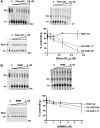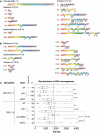Genetic instability triggered by G-quadruplex interacting Phen-DC compounds in Saccharomyces cerevisiae
- PMID: 20223771
- PMCID: PMC2910037
- DOI: 10.1093/nar/gkq136
Genetic instability triggered by G-quadruplex interacting Phen-DC compounds in Saccharomyces cerevisiae
Abstract
G-quadruplexes are nucleic acid secondary structures for which many biological roles have been proposed but whose existence in vivo has remained elusive. To assess their formation, highly specific G-quadruplex ligands are needed. Here, we tested Phen-DC(3) and Phen-DC(6), two recently released ligands of the bisquinolinium class. In vitro, both compounds exhibit high affinity for the G4 formed by the human minisatellite CEB1 and inhibit efficiently their unwinding by the yeast Pif1 helicase. In vivo, both compounds rapidly induced recombination-dependent rearrangements of CEB1 inserted in the Saccharomyces cerevisiae genome, but did not affect the stability of other tandem repeats lacking G-quadruplex forming sequences. The rearrangements yielded simple-deletion, double-deletion or complex reshuffling of the polymorphic motif units, mimicking the phenotype of the Pif1 inactivation. Treatment of Pif1-deficient cells with the Phen-DC compounds further increased CEB1 instability, revealing additional G4 formation per cell. In sharp contrast, the commonly used N-methyl-mesoporphyrin IX G-quadruplex ligand did not affect CEB1 stability. Altogether, these results demonstrate that the Phen-DC bisquinolinium compounds are potent molecular tools for probing the formation of G-quadruplexes in vivo, interfere with their processing and elucidate their biological roles.
Figures





Similar articles
-
The yeast Pif1 helicase prevents genomic instability caused by G-quadruplex-forming CEB1 sequences in vivo.PLoS Genet. 2009 May;5(5):e1000475. doi: 10.1371/journal.pgen.1000475. Epub 2009 May 8. PLoS Genet. 2009. PMID: 19424434 Free PMC article.
-
Stimulation of gross chromosomal rearrangements by the human CEB1 and CEB25 minisatellites in Saccharomyces cerevisiae depends on G-quadruplexes or Cdc13.PLoS Genet. 2012;8(11):e1003033. doi: 10.1371/journal.pgen.1003033. Epub 2012 Nov 1. PLoS Genet. 2012. PMID: 23133402 Free PMC article.
-
G-quadruplex-induced instability during leading-strand replication.EMBO J. 2011 Aug 26;30(19):4033-46. doi: 10.1038/emboj.2011.316. EMBO J. 2011. PMID: 21873979 Free PMC article.
-
Mgs1 function at G-quadruplex structures during DNA replication.Curr Genet. 2021 Apr;67(2):225-230. doi: 10.1007/s00294-020-01128-1. Epub 2020 Nov 25. Curr Genet. 2021. PMID: 33237336 Free PMC article. Review.
-
Mms1 is an assistant for regulating G-quadruplex DNA structures.Curr Genet. 2018 Jun;64(3):535-540. doi: 10.1007/s00294-017-0773-9. Epub 2017 Nov 2. Curr Genet. 2018. PMID: 29098365 Free PMC article. Review.
Cited by
-
G-quadruplexes significantly stimulate Pif1 helicase-catalyzed duplex DNA unwinding.J Biol Chem. 2015 Mar 20;290(12):7722-35. doi: 10.1074/jbc.M114.628008. Epub 2015 Jan 27. J Biol Chem. 2015. PMID: 25627683 Free PMC article.
-
G4 motifs in human genes.Ann N Y Acad Sci. 2012 Sep;1267:53-60. doi: 10.1111/j.1749-6632.2012.06586.x. Ann N Y Acad Sci. 2012. PMID: 22954217 Free PMC article.
-
Exploiting Replication Stress as a Novel Therapeutic Intervention.Mol Cancer Res. 2021 Feb;19(2):192-206. doi: 10.1158/1541-7786.MCR-20-0651. Epub 2020 Oct 5. Mol Cancer Res. 2021. PMID: 33020173 Free PMC article. Review.
-
Physical and functional interaction between yeast Pif1 helicase and Rim1 single-stranded DNA binding protein.Nucleic Acids Res. 2013 Jan;41(2):1029-46. doi: 10.1093/nar/gks1088. Epub 2012 Nov 21. Nucleic Acids Res. 2013. PMID: 23175612 Free PMC article.
-
The relationship between lysine 4 on histone H3 methylation levels of alcohol tolerance genes and changes of ethanol tolerance in Saccharomyces cerevisiae.Microb Biotechnol. 2014 Jul;7(4):307-14. doi: 10.1111/1751-7915.12121. Epub 2014 Apr 30. Microb Biotechnol. 2014. PMID: 24779776 Free PMC article.
References
-
- Phan AT, Kuryavyi V, Luu KN, Patel DJ. Structural diversity of G-quadruplex scaffolds. In: Neidle S, Balasubramanian S, editors. Quadruplex Nucleic Acids. UK: Ch. 3, RSC publishing, Cambridge; 2006. pp. 81–99.
-
- Lipps HJ, Rhodes D. G-quadruplex structures: In vivo evidence and function. Trends Cell. Biol. 2009;19:414–422. - PubMed
-
- Maizels N. Dynamic roles for G4 DNA in the biology of eukaryotic cells. Nat. Struct. Mol. Biol. 2006;13:1055–1059. - PubMed
Publication types
MeSH terms
Substances
LinkOut - more resources
Full Text Sources
Other Literature Sources
Molecular Biology Databases

